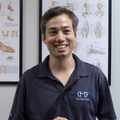
Over 98% of headache sufferers have benign reasons for their headaches. So, although most headaches are not life-threatening, they do affect quality of life significantly, especially in those who suffer from them chronically. A detailed history and exam can help determine when further workup to rule out malignant headaches, is necessary.
The most common types of benign chronic headaches are:
- Tension-Type Headaches – a pressing/tightening non-pulsating headache, usually on both sides of the head (can be felt stronger on one side over the other)
- Migraines Headaches – pulsing/pounding headache, usually on one side of the head and can present with nausea, light/sound sensitivity/spots in front of the eyes
- Cervicogenic Headaches – associated with pain at the base of the head which can refer up to the forehead and eyes, and can be aggravated by neck movements and postures
Note: Chronic headaches are defined as at least 15 headache days per month for at least 3 months, otherwise, they are considered episodic.

Most benign headaches respond well to manual treatments (the type of care we provide here in the office), which address many of the key triggers involved. An average of a 40% improvement can be expected in a 4-8-week course of treatment, while some patients experience total resolution. This can be a life changing experience for chronic headache sufferers. Especially good candidates will have one or more of the following in their history:
- Past head or neck injury from an auto accident or sports injury
- Neck pain and discomfort
- Headaches triggered by stress, which leave your head and neck feeling tense and taught
- Headaches triggered by posture for example:
*Sustained posture- e.g. prolonged sitting at work or in front of the computer
*Awkward posture – e.g. looking overhead to change a lightbulb
- Headaches which are more intense on one side of the head than the other during an episode
Of all the headache types, Tension-Type Headaches are the most common. They affect 10% of the population on any given day. They account for 62% of all headache types whereas Migraines and Cervicogenic headaches are 16% each. When episodic (less than 15 headache days per month), they can become chronic through the overuse of analgesic medications. The result is called an Analgesic Rebound Headache. Most common forms come from medications containing:
- Aspirin
- Acetaminophen (Tylenol)
- Caffeine
Manual procedures and treatments will help avoid this side-effect when used as the first line of defense. They can also address a commonly overlooked headache trigger, neck dysfunction, by improving movement patterns and the posture of the head and neck. A thorough exam can locate areas of soft-tissue dysfunction, muscular imbalances, and joint restrictions which often contribute to headaches.
If you’re looking for a natural, non-invasive approach to headaches, give us a call today!
©CenterForMusculoskeletalFunction2017




